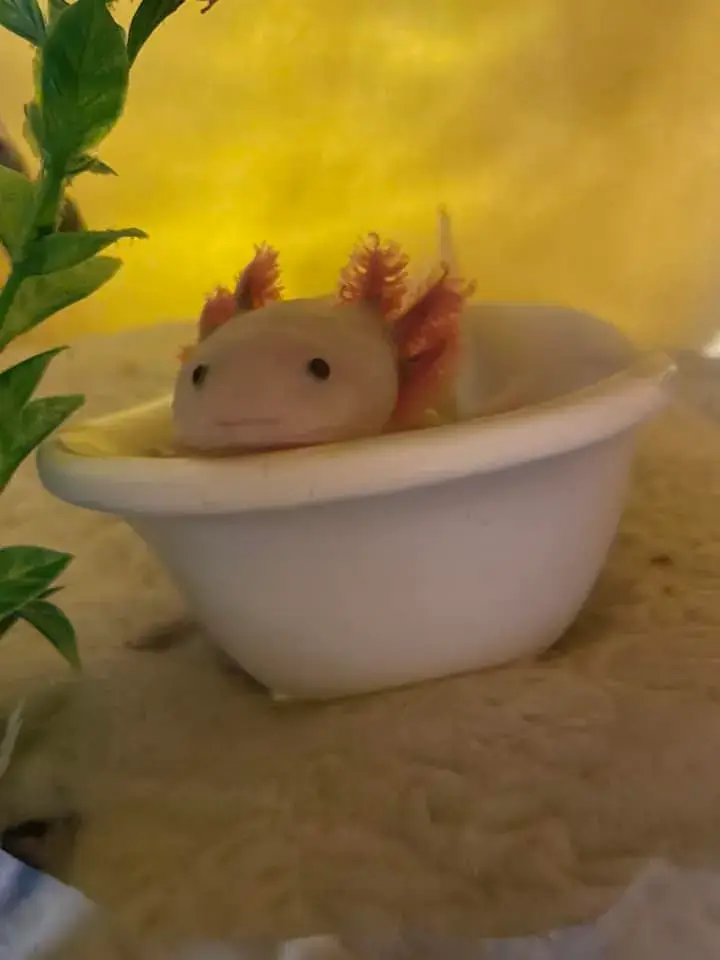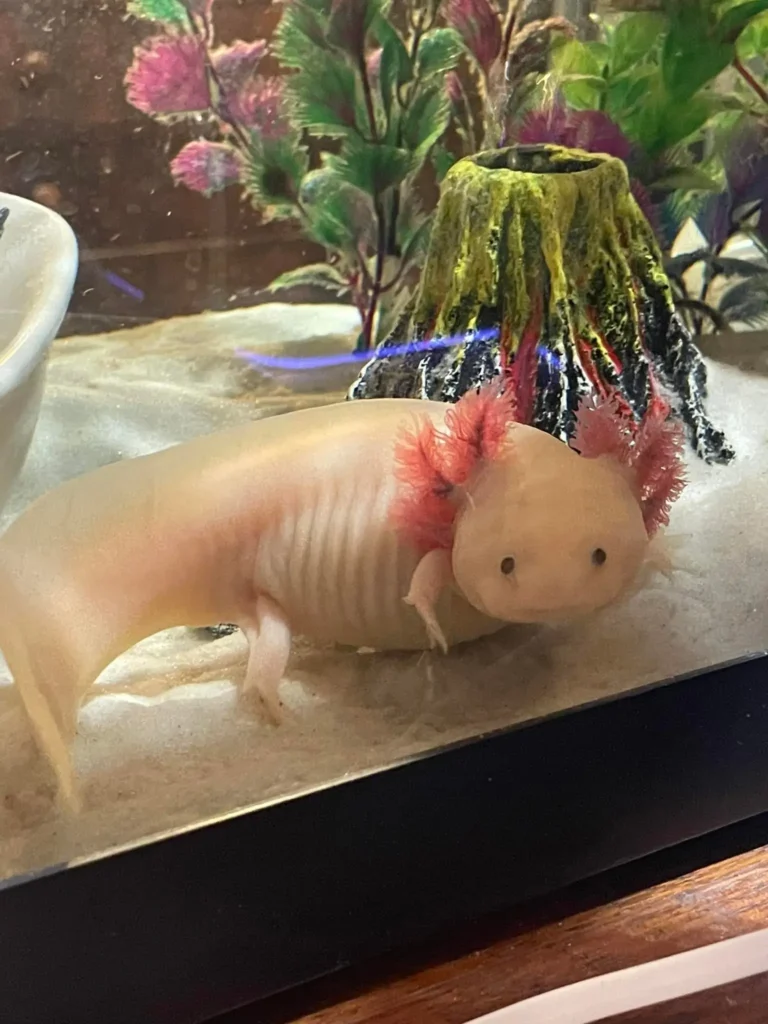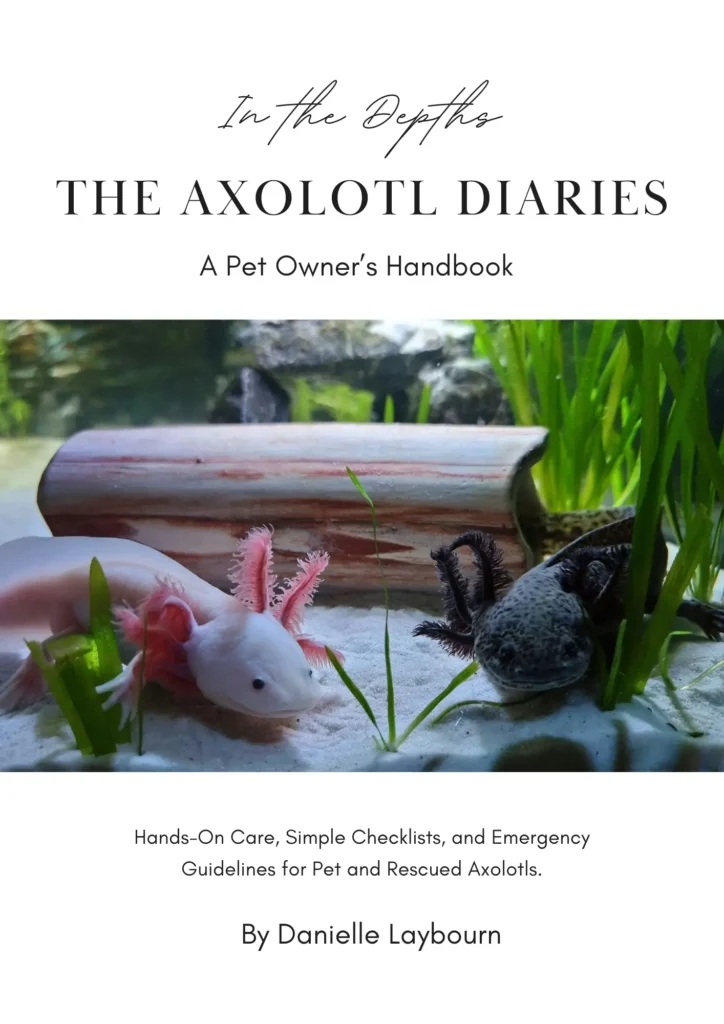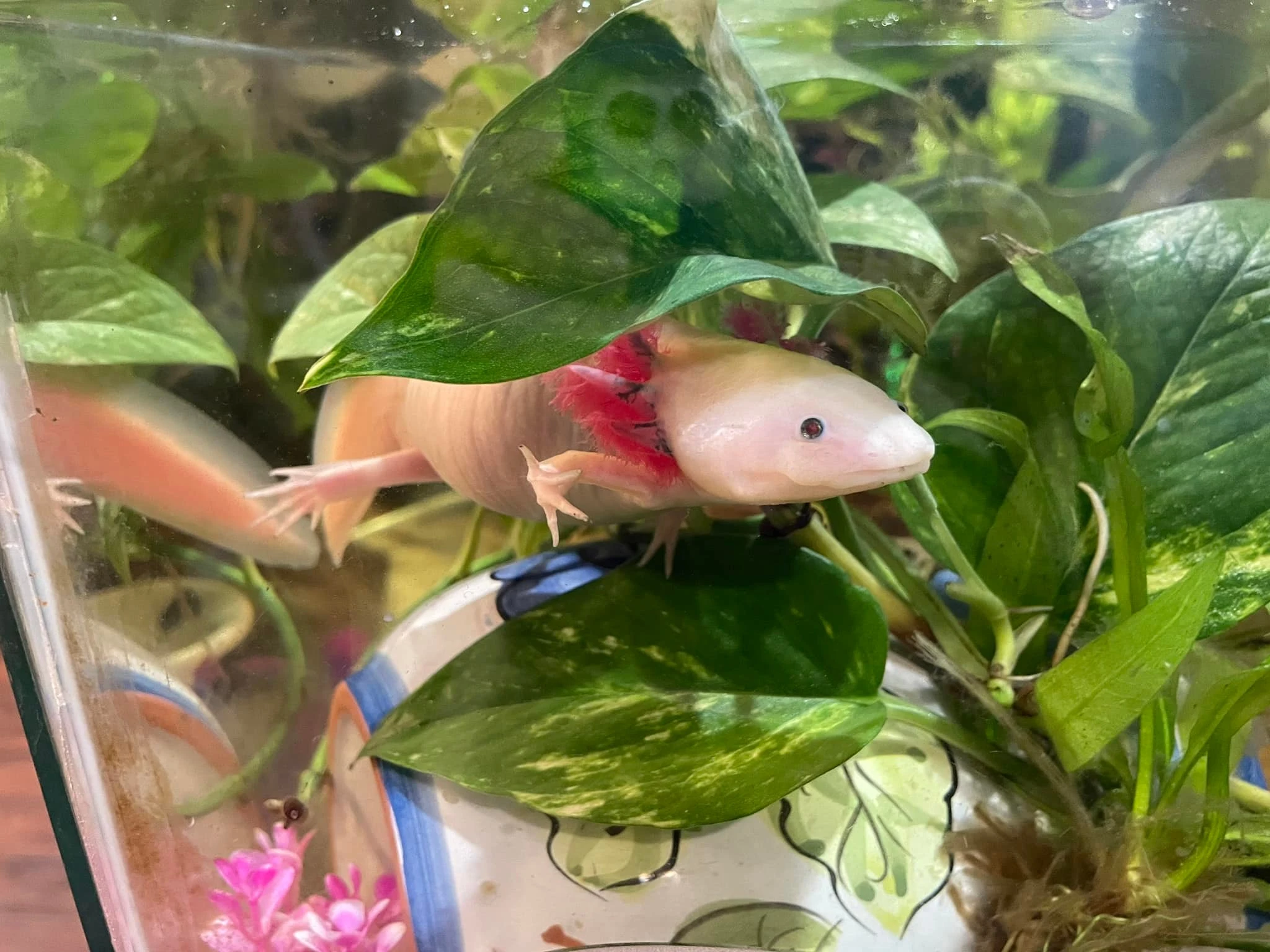Got an axolotl and overwhelmed by how to take care of him? I felt the same when my husband rescued Lucy from a filthy 6-gallon tank.
It took me a lot of reading and mistakes to deal with her impaction, and now she’s even got her floofs back.
So, read on as I’ll try to help you navigate the care process of axolotls. Let’s start!
Table of Contents
Axolotls and Their Biology
Axolotls (Ambystoma mexicanum) are also known as a Mexican walking fish. These neotenic salamanders are native to Lake Xochimilco and Lake Chalco in Mexico.
Being neotenic, they retain their juvenile features into adulthood, like external gills and a mostly aquatic life. They are delicate animals with sensitive skin, they need cool, stable water, and they do best in calm, low-flow tanks.
In the wild, axolotls are grey or brown. But pet axolotls have different morphs, such as white, golden, pink, and albino. What makes axolotls special is their regeneration abilities. They can regenerate their limbs, parts of their hearts, and their brains.
Honestly, axolotls are not easy to care for. The initial tank setup, cleaning, daily care, and feeding requirements are lot. All of this needs serious commitment.
Also Read: Axolotl Growth Stages and Unique Life Cycle
The Tank Setup: Your Axolotl’s Home
Tank will be the home of your axolotl, and the first step is cycling it. If your tank isn’t cycled, tub your axolotl for time being as I did with Lucy. Here are the details:
1. Tank Size Requirements
Axolotl can reach a size of 20-30 cm, and a right tank size is important. For a single axolotl of any age, a 30 gallon tank with a secure lid (to avoid jumping) is must.
However, you can go for a bigger one, like 40 gallons. The bigger, the better, because they need a spacious area for movement, large surface area is must for beneficial bacteria, and high water volume dilutes nitrates more easily.
For housing two axolotls, get a tank size of 60-75. Although I won’t recommend growing multiple axolotls due to nipping risks.
The tank should be larger horizontally than vertically tall because axolotls are bottom dwellers. They prefer to remain at the bottom rather than swim on top of the tank. Therefore, a wider tank (60cm x 30 cm) provides them more space to explore.
Your should be of high-quality material that is designed to support substrate and decorations inside. There are reported cases where the tank bottom cracked due to heavy decorations placed in the tank.
2. Substrate Options
Once you select the correct size of the tank, then you need to select a substrate, that don’t pose an impaction risk.
Some safe substrate options are fine sand, large rocks, and tiles. Axolotls are known to eat everything around them, so avoid using pebbles, gravel, and stones of the same size as their heads. Gravel is not safe because of its size (2mm). Axoltls can be ingest it, and it’ll lead to impaction.
I use CaribSea Super Naturals Sand of grain size less than 1mm. Even if the axolotl eat accidentally, it can easily pass it out. However, avoid substrates for juveniles and keep the bare bottom until they reach an adult size.

You can go for bare bottom too. It’s easy to clean, but not aesthetically pleasing. Also, an adult axolotl needs something to grip while walking, which glass cannot offer.
You can also arrange large rocks in the tank. Still confused? I’ve written about options in details in this tank substrate guide.
3. Decor and Hiding Spots
Next, you can set-up decorations and hiding spots for your axolotl in the tank.
Axolotls are nocturnal, solitude lovers, and like to explore the surroundings. Hiding spots such as PVC pipes, Terracotta pots, driftwood, and custom-made slate hides give them a comfortable environment, a sense of security, and reduce stress.
I arranged plenty of hiding spots in the tank, and focused on smooth surfaces with no rough edges. You can try aquatic-safe glue for sticking the decorations on the tank wall and base. They should be non-toxic and large enough to prevent impaction.
- Live Plants: Plants make a great decor in the water tank. But axolotl are sensitive to light, so select plants that can thrive in low light and cold water. Some of the great options are Java moss, Elodea, Java fern, Anubias, Live Marimo balls, and Hornwort. I’ve got Pothos and Amazon Swords in Lucy’s tank. Avoid plants with spindly leaves because they might get tangled in axolotl’s feathery gills.
I found some cute decorations online for Lucy’s tank. She loves to sit in the glazed ceramic bowl, and wanders along the volcano bubbler. I also got a resin hollow tree trunk and terrarium decor for her tank.


You can check them out if they match your aesthetics and budget. I rearrange them occasionally to keep it adventurous for Lucy.
4. Cycle Your Tank and Maintain Water Parameters
Water quality is the most important part of axolotl care. I can’t stress it enough. The tank must be cycled before introducing your axolotl to it. It will keep the water safe and healthy for your axolotl.
Buy a freshwater test kit and check ammonia, nitrite, nitrate, and pH at least weekly while cycling, then regularly after. I prefer liquid test kits that are more accurate than traditional test strips. These are also easy to use, you just need to follow the instructions on the kit.
Add reagents to the water sample, then match it with the color chart provided. You’ll be able to accurately test each water parameter.
Read my detailed guide on tank cycling for a better understanding of the process.
Target Water Parameters
| Parameter | Ideal Range | Why It Matters | How to Test |
| pH | 6.5 – 8.0 | Stable pH is must for nitrogen cycle. High pH leads to high ammonia concentration and nitrite toxicity. | Liquid test kit or pH meter |
| Ammonia | 0 ppm | Zero tolerance of high levels by axolotls. Highly toxic. Burns gills and skin, causes organ damage. | Liquid test kit |
| Nitrite | 0 ppm | Zero tolerance of high levels. Highly toxic. Interferes with oxygen uptake, and cause suffocation. | Liquid test kit |
| Nitrate | < 20 ppm | Axoltls can tolerate small concentrations. It’s less toxic, but high levels cause stress and health issues. | Liquid test kit |
How to Cycle Your Tank?
The nitrogen cycle is the chain of biochemical reactions whose main purpose is to deal with axolotl waste. It takes around 4-8 weeks to cycle the tank fully.
- Naturally, ammonia builds up through the breakdown of uneaten food and axolotl waste. But in cycling, you need to add ammonia to start the Nitrogen cycle. Start by adding 2 drops per gallon of Dr. Tim’s Ammonium Chloride. Test the ammonia level daily by using the API test kit. It should be 2-5 ppm initially.
- Add cultured live bacteria (Nitrosomonas and Nitrobacter) and Seachem Prime. Nitrosomonas converts Ammonia into Nitrite. Test the water for ammonia and nitrite presence, and you will notice the initial nitrite spike with a decrease in ammonium concentration.
- When ammonia and nitrite concentration is 0 ppm, test for nitrate levels. If it is between 5-15 ppm, it means Nitrobacter is doing a good job converting nitrite into nitrates. Nitrate presence is the last stage of the Nitrogen cycle. It indicates the tank is cycled. Partial water changes remove nitrates.

5. Filtration and Water Flow
Water filters are another essential aspect. Avoid using filters that produce high water flow and strong currents. Axolotls might struggle to move in strong currents and it can stress them and damage their delicate gills. Here are the recommended filter types:
Sponge Filters
I use dual sponge filter by Hygger, and love the practicality of sponge filters. They:
- offer excellent biological filtration (provide surface area for bacteria)
- have a gentle flow
- are air-driven
- inexpensive
- and collect debris and floating particles
Cons: Can be bulky, and sometimes not enough alone.
Also Read: How to Setup Your Sponge Filter?
Baffled Hang-on-Back (HOB) Filters
HOB filters are also good option but some of them often have a strong flow and require baffling (redirecting the output flow) to be suitable.
HOB and Canister filters have their own pumps. Simply install them and add water. Some people prefer to HOB media cavity with reusable media or filter floss, which will increase the filtration. You can make a DIY baffle out of a soap dish or plastic bottle and attach it to the output.
Do not replace the filter media after the tank is cycled because beneficial bacteria are colonized on its surface. The best way to clean it is to gently wash it in old tank water without disturbing the bacterial colony. Sponge filter media should be cleaned after 3-4 weeks, while HOB should be rinsed after 4-8 weeks.
6. Feeding Your Axolotl
Axolotls are carnivores but opportunistic predators. Due to poor eyesight and a keen sense of smell, they quickly swallow when something moves and comes near them. They enjoy earthworms, blackworms, bloodworms, and European nightcrawlers.
Earthworms and nightcrawlers are stable food options in terms of nutritional value. They are full of protein and high calcium and phosphorus levels. I usually get mine from Uncle Jim’s Worm Farm. Also, occasionally treat your axolotl with cooked shrimps, frozen bloodworms, and sinking pellets. But do not solely depend upon them as a complete meal due to their limited nutrients.
Ensure they are from a safe source, disease-free, and not wild-caught. You can also start your worm farm to grow healthy and safe food for axolotl. Check my blog on how to start your worm bin.
Avoid feeder fish such as minnows because they contain thiaminase, which can cause thiamine deficiency if consumed consistently. Also, fish are potential carriers of pathogens and diseases.
Do not leave the food in the axolotl tank and hope that the axolotl will eat it. Offer them food through tongs or tweezers, or drop it near their head to get their attention. Remove uneaten food after 15-20 minutes. Uneaten food will rot and affect your water quality. The amount of food should be as much as they can eat in few minutes.
| Age of Axolotl | Food type | Feeding Schedule |
| Hatchling (24-72 hours) | Live moving food. Baby brine shrimp, microworms, live vinegar eels, white worms, Daphnia. | 2-3 times daily. Feed them when the stomach changes colour. |
| Juvenile (4 weeks to 3 inches in size) | Live food. Blackworms, Daphnia, adult brine shrimp | 2-3 times daily |
| Adult (4-9 inches) | Can offer both live and non-moving food. Earthworms’ pieces, red wiggler (blanched and cooled), pellets (treat). | 1-2 times daily |
| Adult (9-inches to mature size) | Live food, non-moving food Earthworms, blood worms (treat). | 2-3 time weekly |
Read more about axolotl nutrition here.
7. Water Changes and Tank Cleaning
Axolotls have a high bioload and you may face ammonia spikes. Regular water changes will help to maintain water stability. In a fully cycled tank, a 20-25% weekly water change is recommended.
Moreover, do spot cleaning, such as uneaten food by using a turkey buster. Use a gravel siphon to clean the water from the bottom and under decorations.
When changing the water, always treat it first with a de-chlorinator and adjust the temperature. Algae growth is common in axolotl tanks due to the presence of nitrogenous compounds.
However, algae flourish in bright light, so adjust the light levels to prevent them. You can easily clean the glass with an aquarium-safe scrubber. I use a magnetic cleaner by Mag-Float. Never use chemical algae removers, as they can be toxic to axolotls.
Also Read: Magnetic Aquarium Cleaner | How to Use Them

8. Health, Diseases, and Troubleshooting
Healthy axolotls have an active, plump body, healthy-looking gills (large and feathery), alert eyes, and a good appetite. They love to stay at the bottom and occasionally swim around. Sometimes axolotl gills are dark red, with lighter skin color than on normal days. It’s due to increased blood flow, which is completely normal.
Some behaviors that indicate stress or illness are loss of appetite, curled gills, lethargy, pale color, clamped legs or tail, frequent floating, scratching gills with back legs, lack of responsiveness, and loss of gill color. Axolotl outer slime acts as a protective coat and first defense mechanism against infections. If it gets damaged, fungus and bacteria can attack it often.
- Fungus issue looks like white fuzzy patches which can be treated with cool, clean water, but avoid salt baths. If infection persists, consult a veterinarian.
- Fin Rot or Gill Rot is caused by bacteria, typically due to poor water quality. Check the water parameters and improve the water quality immediately.
- Buoyancy Issues (Floating/Sinking) can be caused by gulping air, substrate ingestion, and impaction. Fasting can help to solve the issue. However, impaction is a serious issue, and you should consult the vet.
- Stress caused by poor water quality and high temperature can be managed by partial water changes and pouring frozen water bottles for immediate cooling.
- Missing limbs/gills/toes caused by nipping from tank mates or injury due to decor. Remove sharp and coarse objects from the tank. Isolate if required.
When to Seek Veterinary Help:
- If you suspect impaction, then consult a veterinarian.
- A severe bacterial and fungal infection that is spreading rapidly.
- Refusal to eat for more than 2 weeks.
- Any symptom you are not sure about and did not solve with a water change.
Read more about axolotl illnesses, the symptoms, and treatment plans.
9. Lighting and Environment
Axolotls do not prefer bright light, as it stresses them. Plus, they are nocturnal and like darkness under the plants and decorations. So place the tank strategically in dimly lit rooms. Also, add hiding spots in tank, arrange decorations, live plants, and a substrate for traction.
10. Handling and Interaction
You or your kids might want to touch axolotls, but it’s not recommended. Axolotls have delicate skin and gills, and their slime coat can be damaged easily. Avoid direct handling, and if necessary (for health inspection), use a net made of soft mesh to guide them gently. Clean and wet your hands thoroughly if brief contact is unavoidable.
11. Tank Mates
Axolotls do not need a companion. And housing multiple axolotls is not recommended. There is a risk of cannibalism, nipping, injury, and stress to both animals. Juveniles often bully adults due to space and food competition. The size difference is the main reason for cannibalism.
Anything that fits in the axolotl’s mouth is like food for them, even if it is other axolotls.
So, there’s a risk of choking, impaction, and even death. Also, goldfish or plecos are not safe tank mates. They either nip, carry disease, or pose an impaction risk.
Expert Tip: Only consider cohabitation if axolotls are the same size, same sex, in a very large tank, with lots of hiding spots. And be ready to separate them at the first sign of trouble.
Read about all tank mate possibilities here.
Also Read:
The Axolotl Diaries

A clear, step-by-step handbook (50+ pages) about axolotl care that covers basics, safe tank requirements, cycling, feeding, common health issues, and more.
Rescue-informed and vet-aware. For anyone who wants to raise a healthy, happy axolotl.
Find everything in plain language, backed by real experience.
Grab printable cheatsheets, practical tips, and easy troubleshooting guide inside!
Price: $14.99
Final Thoughts
Caring for axolotls is easy once you get a hang of it. You need to keep things calm and steady. Keep the water cool and clean, use low flow filtration like a sponge filter, and stick to fine sand or a bare bottom.
Feed a proper carnivore diet on a regular schedule, avoid handling, and test water regularly so you catch problems early. I rescued Lucy and learned that small mistakes add up, so start simple and adjust as you go.
Watch appetite, gills, and behavior, and get help from an aquatic vet or experienced keeper if something looks wrong. Have a steady routine and attention to water, and your axolotl will thrive and become a real joy to keep!

